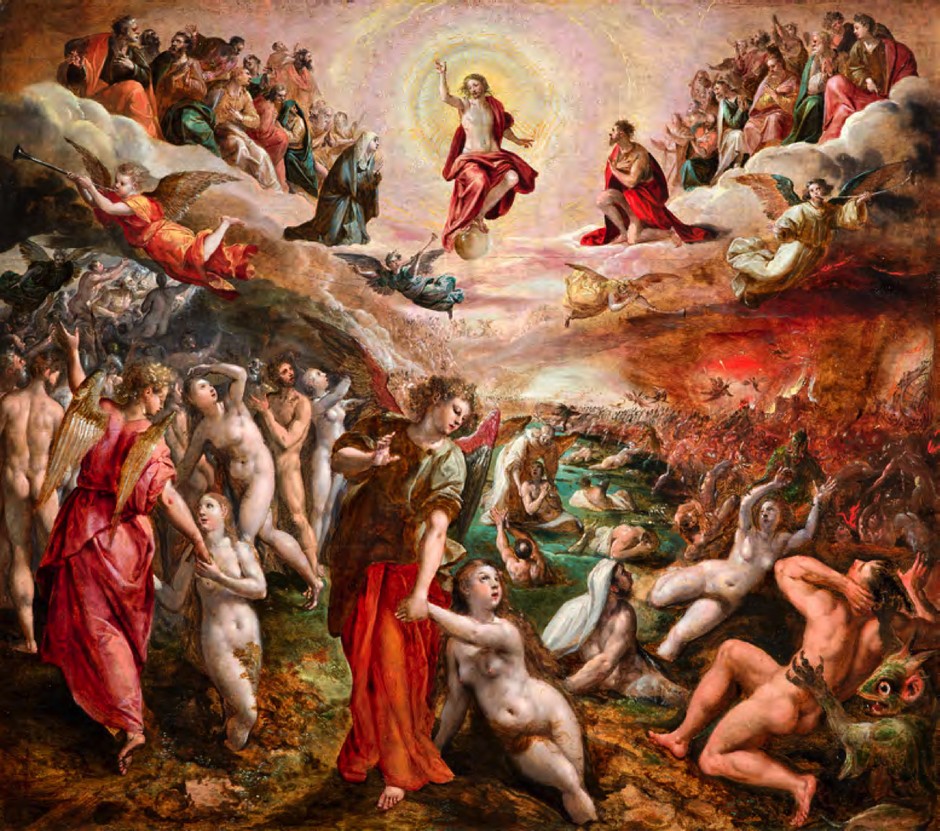The surreality of heaven and hell is living in art to this day. Not perhaps as clearly as provoked by the Christian doctrine, but the double nature of the world, its beautiful countenance and hidden defects are found in art throughout many eras.
A few weeks ago, I met the artist Miljard Kilk. One of the most famous hyperrealists in Estonia. His creation today has moved away from hyperrealism. It is rather surreal, and it is moving in those hell and heaven spheres, which will remind you of the Renaissance of the Netherlands, Hieronymos Bosch or the exulted subconscious undercurrents of the 20th century or of Salvador Dali.
I had not met with Miljard for nearly 15 years. Our conversation became inspirational; time did not matter. We looked at the photos of his last works with a large magnifying lens, which Miljard had with him, in order to delve into each detail. Next to Hieronymos Bosch, I was reminded of his contemporary Marten de Vos' painting “The Last Judgement".
The Bible repeatedly talks about the judgement that God places over mankind, when he appears in his glory to separate the meek sinners and accept the first ones to Heaven and send others to Hell. Marten de Vos expresses this strong episode with an enormous captivating emotion, focusing on the crowds, forwarding the rhythm of the figures’ movement, confronting the colouring of the "sinner" and the "fair" by bringing out their specialties. The work's dynamic composition and perspectives from different points of view create an illusion of the admixture of the world by the opening of the central heavenly sky on Judgement Day.
The colours of Vos shone through in today's work of Miljard, not just the colour but also the colouring of senses. Surrealism, plots of the Renaissance and 20th century mystery shone through as well. Miljard Kligi's paintings had the effect of a strange portrait, which covers the whole era, something that was and still is, but only through a convincing and personal creator’s vision. All of a sudden, art again seemed to be the quiet speech of time, space and the creative individual, to which the viewer is invited to intervene.
Hieronymos Bosch was a Dutch painter in the 15–16 centuries, whose main subject was Hell. Bosch made the delirious nature of the imagination come alive by painting an "aggregate face" of horrors, surely frightening you to refrain from sin. Bosch was allegedly convinced that people are sinners by nature and this cannot be fixed by anything; despite the dreads he was using to keep them away from Hell, people would get there anyway.
But this is not the main point here. The key is Bosch’s style. His enormous fantasy has a stunning effect even today. At times it is hard to believe that people and society in that time could so visibly communicate with such cosmic mystified worlds, and create them so freely in “black and white”. The secular reality and its logical and well-behaved incorporation with the Christian morality seems to be far from fantasy, regulated and canonised. Yes, the Christian compositions were powerful just as its architecture, but this enormous power was conferred to the Biblical stories, their real characters, attempting to conquer the senses to obey the higher power with their scope.
Hell was perhaps the only thing that gave possibilities to the unrestricted proliferation of the subconsciousness. Bosch had the courage to zoom into the deepest duskiness, creating some scary creatures, indescribable fantasy demons, next to which the Medieval torture chambers grow pale.
Today, where our fantasies are encouraged by the possibilities of modern media, it seems that we can imagine all kinds of incomprehensible creatures and their appalling nature seems normal, their shyness is often even ridiculous. At the same time, the demons of the Christian culture were supposed to penetrate the deep interior of the nation and do their work in this prevailing illiteracy, affecting the masses and exhorting them to obedience. None of the then Hell boilers control us today, however, the pictures of them have put the subsequent surrealism into motion – from the Renaissance to 20th century Europe.
Hieronymos Bosh was appointed as a surrealist posthumously, as the worlds he created were clearly feeding this flow. Surrealism – suppressed release of the subconscious and its expression. Flow, which started in post First World War Paris, revealed itself in art and literature. Joan Miro, René Magritte, Max Ernst, Salvador Dali – Sigmund Freud and his psychoanalysis.
All of these trains of thought can seem like a form of saltatory chaos, taking something from one and then from another art period. Throwing together flavours and aromas that seem so far from each other that their mingling seems impossible, but yet everything is in everything. The invisible energy thread of what had been, feeds art today. Heaven does not exist without Hell, the beginning does not exist without the end.
Looking at art on a longer timeline we can see a line of sequence – Bosch becomes Magritte and Dali and Miljard Kilk. It is easy to imagine this in moving computer graphics. But none of these names contain the actual matter; matter is not in the person who creates the art, but in the energy that directs them to create.
.png)
